新闽教版六年级下册英语教学参考书
- 格式:doc
- 大小:482.00 KB
- 文档页数:80
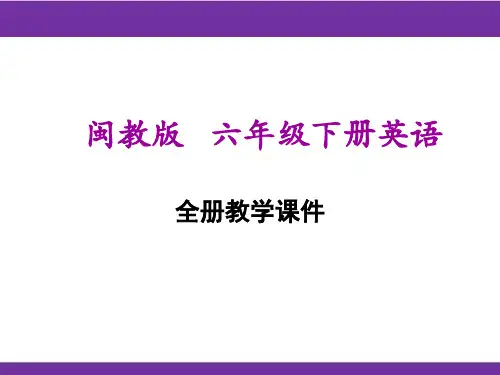
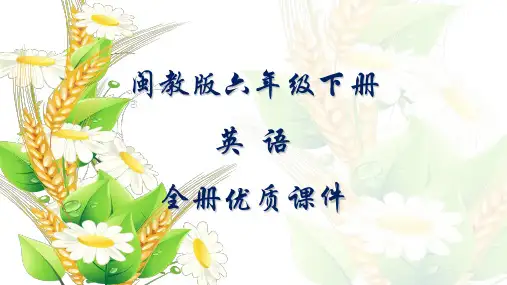
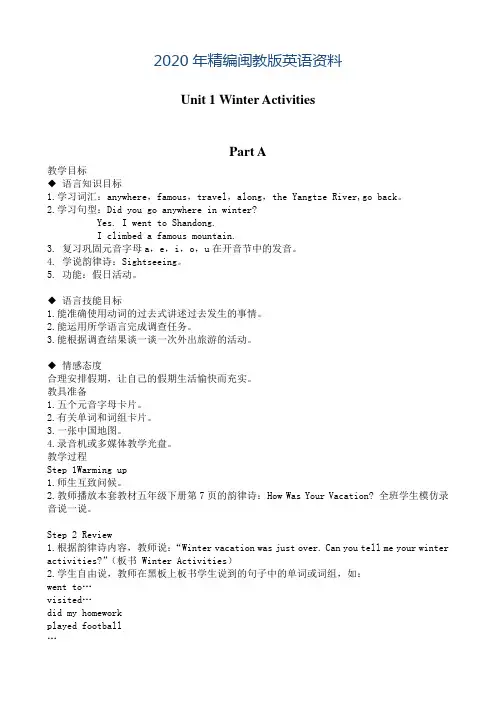
2020年精编闽教版英语资料Unit 1 Winter ActivitiesPart A教学目标◆语言知识目标1.学习词汇:anywhere,famous,travel,along,the Yangtze River,go back。
2.学习句型:Did you go anywhere in winter?Yes. I went to Shandong.I climbed a famous mountain.3. 复习巩固元音字母a,e,i,o,u在开音节中的发音。
4. 学说韵律诗:Sightseeing。
5. 功能:假日活动。
◆语言技能目标1.能准确使用动词的过去式讲述过去发生的事情。
2.能运用所学语言完成调查任务。
3.能根据调查结果谈一谈一次外出旅游的活动。
◆情感态度合理安排假期,让自己的假期生活愉快而充实。
教具准备1.五个元音字母卡片。
2.有关单词和词组卡片。
3.一张中国地图。
4.录音机或多媒体教学光盘。
教学过程Step 1Warming up1.师生互致问候。
2.教师播放本套教材五年级下册第7页的韵律诗:How Was Your Vacation? 全班学生模仿录音说一说。
Step 2 Review1.根据韵律诗内容,教师说:“Winter vacation was just over. Can you tell me your winter activities?”(板书 Winter Activities)2.学生自由说,教师在黑板上板书学生说到的句子中的单词或词组,如:went to…visited…did my homeworkplayed football…3.教师出示学过的动词原形及其过去式,复习它们的音、义、形及变化规律。
4.教师再出示一些动词词组,如:took some photos,went skating,climbed a mountain,listened to music等,进行复习巩固活动。
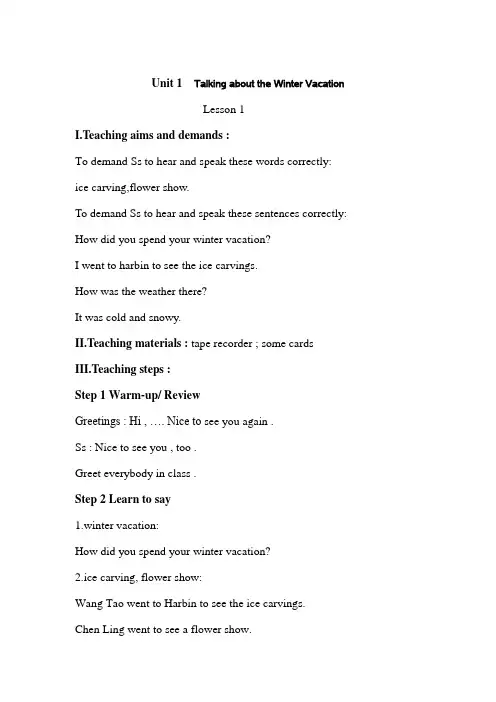
Unit 1 Talking about the Winter VacationLesson 1I.Teaching aims and demands :To demand Ss to hear and speak these words correctly: ice carving,flower show.To demand Ss to hear and speak these sentences correctly: How did you spend your winter vacation?I went to harbin to see the ice carvings.How was the weather there?It was cold and snowy.II.Teaching materials : tape recorder ; some cardsIII.Teaching steps :Step 1 Warm-up/ ReviewGreetings : Hi , …. Nice to see you again .Ss : Nice to see you , too .Greet everybody in class .Step 2 Learn to say1.winter vacation:How did you spend your winter vacation?2.ice carving, flower show:Wang Tao went to Harbin to see the ice carvings.Chen Ling went to see a flower show.3.sunny, cloudy, rainy, snowy, warm, hot, cool, cold:How is the weather in…?It is…4.is-was, do-did, go-went, snow-snowed, watch-watched, read-read, make-made.Step 3 PracticeAsk the Ss to listen to the tape recorder and answer the following questions:How did Wang Tao spend his winter vacation?How did Chen Ling spend her winter vacation?How was the weather in Harbin?How was the weather in Guangzhou?(look and say with the teacher.Divide the Ss into two groups to act out the two dialogs.Ask two Ss to act out the dialogs for some times .)Step 4 Look and sayListen to the tape & look at the English books and point to the pictures. Listen to the tape again & repeat: see the ice carvings, see a flower show, went to the fair, watched New Year programs, read interesting books, made snowmen, at Spring FestivalStep 5 Ask and answerFinish part4: Read. Tick or cross.Step 6 HomeworkListen to the tape & repeat for some times .Finish off the activity book of this Lesson .Lesson 2I.Teaching aims and demands :To demand Ss to hear and speak these words correctly: Seaside, wedding, met.To demand Ss to hear and speak these sentences correctly: Where were you in the winter vacation?I went to Hainan with my family.What did you do there?We played at the seaside.II.Teaching materials : tape recorder ; some cardsIII.Teaching steps :Step 1 Warm-up/ ReviewGreeting each other.Review verbs: is, are, go, do, play, climb, stay, learn,meet及其过去式。
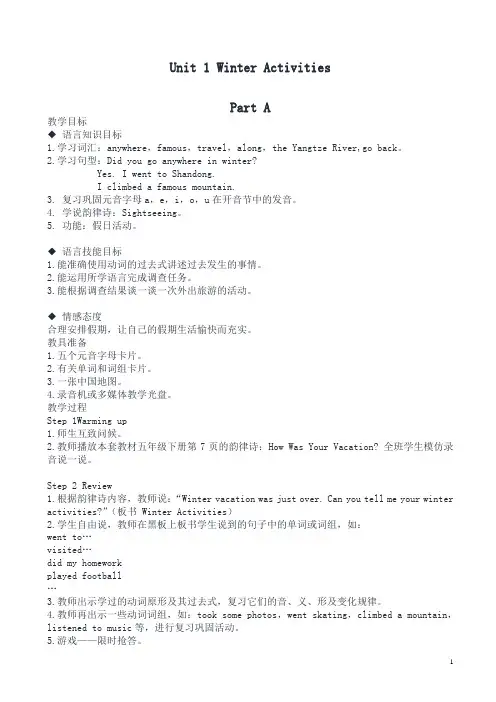
Unit 1 Winter ActivitiesPart A教学目标◆语言知识目标1.学习词汇:anywhere,famous,travel,along,the Yangtze River,go back。
2.学习句型:Did you go anywhere in winter?Yes. I went to Shandong.I climbed a famous mountain.3. 复习巩固元音字母a,e,i,o,u在开音节中的发音。
4. 学说韵律诗:Sightseeing。
5. 功能:假日活动。
◆语言技能目标1.能准确使用动词的过去式讲述过去发生的事情。
2.能运用所学语言完成调查任务。
3.能根据调查结果谈一谈一次外出旅游的活动。
◆情感态度合理安排假期,让自己的假期生活愉快而充实。
教具准备1.五个元音字母卡片。
2.有关单词和词组卡片。
3.一张中国地图。
4.录音机或多媒体教学光盘。
教学过程Step 1Warming up1.师生互致问候。
2.教师播放本套教材五年级下册第7页的韵律诗:How Was Your Vacation? 全班学生模仿录音说一说。
Step 2 Review1.根据韵律诗内容,教师说:“Winter vacation was just over. Can you tell me your winter activities?”(板书 Winter Activities)2.学生自由说,教师在黑板上板书学生说到的句子中的单词或词组,如:went to…visited…did my homeworkplayed football…3.教师出示学过的动词原形及其过去式,复习它们的音、义、形及变化规律。
4.教师再出示一些动词词组,如:took some photos,went skating,climbed a mountain,listened to music等,进行复习巩固活动。
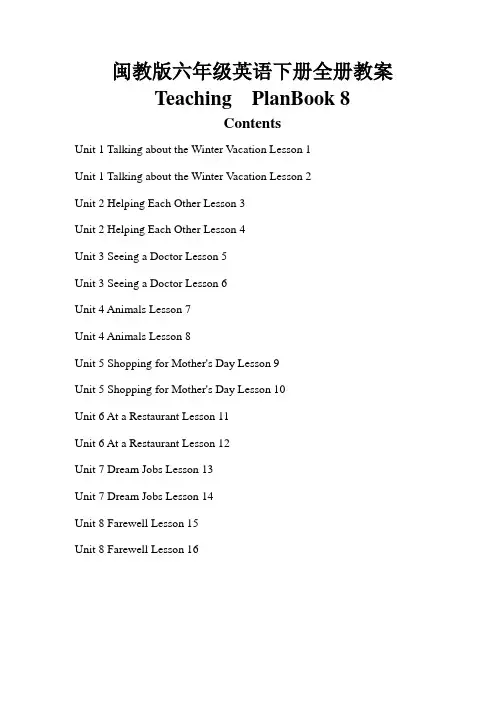
闽教版六年级英语下册全册教案Teaching PlanBook 8ContentsUnit 1 Talking about the Winter Vacation Lesson 1Unit 1 Talking about the Winter Vacation Lesson 2Unit 2 Helping Each Other Lesson 3Unit 2 Helping Each Other Lesson 4Unit 3 Seeing a Doctor Lesson 5Unit 3 Seeing a Doctor Lesson 6Unit 4 Animals Lesson 7Unit 4 Animals Lesson 8Unit 5 Shopping for Mother's Day Lesson 9Unit 5 Shopping for Mother's Day Lesson 10Unit 6 At a Restaurant Lesson 11Unit 6 At a Restaurant Lesson 12Unit 7 Dream Jobs Lesson 13Unit 7 Dream Jobs Lesson 14Unit 8 Farewell Lesson 15Unit 8 Farewell Lesson 16Unit 1 Talking about the Winter VacationLesson 1I.Teaching aims and demands :To demand Ss to hear and speak these words correctly:ice carving,flower show.To demand Ss to hear and speak these sentences correctly:How did you spend your winter vacation?I went to harbin to see the ice carvings.How was the weather there?It was cold and snowy.II.Teaching materials : tape recorder ; some cardsIII.Teaching steps :Step 1 Warm-up/ ReviewGreetings : Hi , …. Nice to see you again .Ss : Nice to see you , too .Greet everybody in class .Step 2 Learn to say1.winter vacation:How did you spend your winter vacation?2.ice carving, flower show:Wang Tao went to Harbin to see the ice carvings.Chen Ling went to see a flower show.3.sunny, cloudy, rainy, snowy, warm, hot, cool, cold:How is the weather in…?It is…4.is-was, do-did, go-went, snow-snowed, watch-watched, read-read, make-made.Step 3 PracticeAsk the Ss to listen to the tape recorder and answer the following questions:How did Wang Tao spend his winter vacation?How did Chen Ling spend her winter vacation?How was the weather in Harbin?How was the weather in Guangzhou?(look and say with the teacher.Divide the Ss into two groups to act out the two dialogs.Ask two Ss to act out the dialogs for some times .)Step 4 Look and sayListen to the tape & look at the English books and point to the pictures. Listen to the tape again & repeat: see the ice carvings, see a flower show, went to the fair, watched New Year programs, read interesting books, made snowmen, at Spring FestivalStep 5 Ask and answerFinish part4: Read. Tick or cross.Step 6 HomeworkListen to the tape & repeat for some times .Finish off the activity book of this Lesson .Lesson 2I.Teaching aims and demands :To demand Ss to hear and speak these words correctly:Seaside, wedding, met.To demand Ss to hear and speak these sentences correctly:Where were you in the winter vacation?I went to Hainan with my family.What did you do there?We played at the seaside.II.Teaching materials : tape recorder ; some cardsIII.Teaching steps :Step 1 Warm-up/ ReviewGreeting each other.Review verbs: is, are, go, do, play, climb, stay, learn,meet及其过去式。
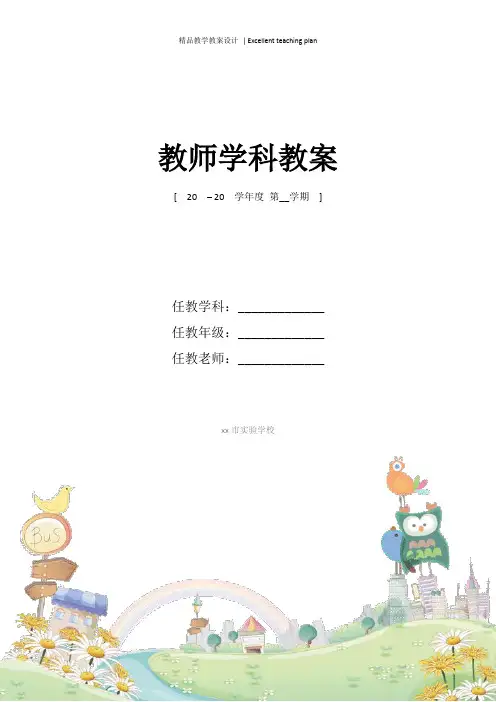
教师学科教案[ 20 – 20 学年度第__学期]任教学科:_____________任教年级:_____________任教老师:_____________xx市实验学校Unit 1 Winter ActivitiesPart A教学目标◆语言知识目标1.学习词汇:anywhere,famous,travel,along,the Yangtze River,go back。
2.学习句型:Did you go anywhere in winter?Yes. I went to Shandong.I climbed a famous mountain.3. 复习巩固元音字母a,e,i,o,u在开音节中的发音。
4. 学说韵律诗:Sightseeing。
5. 功能:假日活动。
◆语言技能目标1.能准确使用动词的过去式讲述过去发生的事情。
2.能运用所学语言完成调查任务。
3.能根据调查结果谈一谈一次外出旅游的活动。
◆情感态度合理安排假期,让自己的假期生活愉快而充实。
教具准备1.五个元音字母卡片。
2.有关单词和词组卡片。
3.一张中国地图。
4.录音机或多媒体教学光盘。
教学过程Step 1Warming up1.师生互致问候。
2.教师播放本套教材五年级下册第7页的韵律诗:How Was Your Vacation? 全班学生模仿录音说一说。
Step 2 Review1.根据韵律诗内容,教师说:“Winter vacation was just over. Can you tell me your winter activities?”(板书 Winter Activities)2.学生自由说,教师在黑板上板书学生说到的句子中的单词或词组,如:went to…visited…did my homeworkplayed football…3.教师出示学过的动词原形及其过去式,复习它们的音、义、形及变化规律。
4.教师再出示一些动词词组,如:took some photos,went skating,climbed a mountain,listened to music等,进行复习巩固活动。
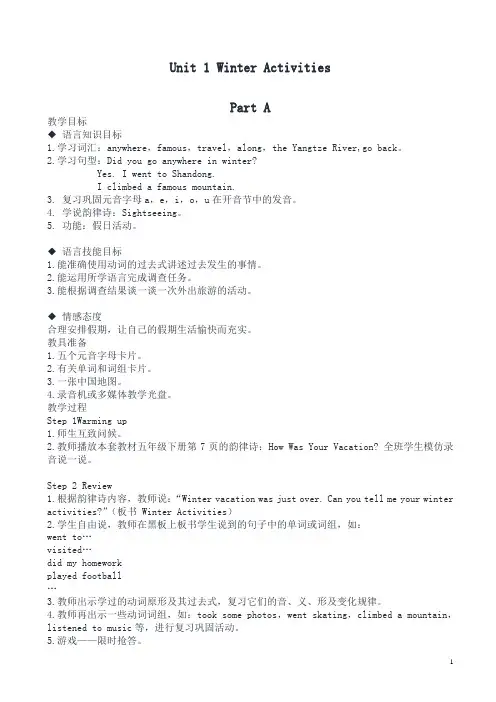
Unit 1 Winter ActivitiesPart A教学目标◆语言知识目标1.学习词汇:anywhere,famous,travel,along,the Yangtze River,go back。
2.学习句型:Did you go anywhere in winter?Yes. I went to Shandong.I climbed a famous mountain.3. 复习巩固元音字母a,e,i,o,u在开音节中的发音。
4. 学说韵律诗:Sightseeing。
5. 功能:假日活动。
◆语言技能目标1.能准确使用动词的过去式讲述过去发生的事情。
2.能运用所学语言完成调查任务。
3.能根据调查结果谈一谈一次外出旅游的活动。
◆情感态度合理安排假期,让自己的假期生活愉快而充实。
教具准备1.五个元音字母卡片。
2.有关单词和词组卡片。
3.一张中国地图。
4.录音机或多媒体教学光盘。
教学过程Step 1Warming up1.师生互致问候。
2.教师播放本套教材五年级下册第7页的韵律诗:How Was Your Vacation? 全班学生模仿录音说一说。
Step 2 Review1.根据韵律诗内容,教师说:“Winter vacation was just over. Can you tell me your winter activities?”(板书 Winter Activities)2.学生自由说,教师在黑板上板书学生说到的句子中的单词或词组,如:went to…visited…did my homeworkplayed football…3.教师出示学过的动词原形及其过去式,复习它们的音、义、形及变化规律。
4.教师再出示一些动词词组,如:took some photos,went skating,climbed a mountain,listened to music等,进行复习巩固活动。
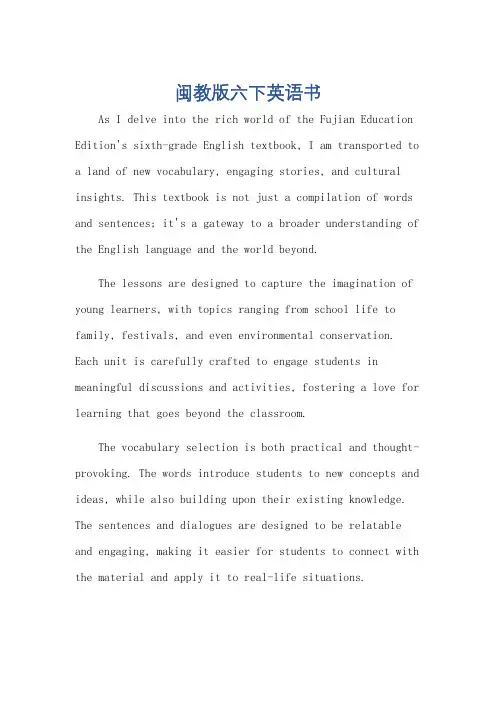
闽教版六下英语书As I delve into the rich world of the Fujian Education Edition's sixth-grade English textbook, I am transported to a land of new vocabulary, engaging stories, and cultural insights. This textbook is not just a compilation of words and sentences; it's a gateway to a broader understanding of the English language and the world beyond.The lessons are designed to capture the imagination of young learners, with topics ranging from school life to family, festivals, and even environmental conservation. Each unit is carefully crafted to engage students in meaningful discussions and activities, fostering a love for learning that goes beyond the classroom.The vocabulary selection is both practical and thought-provoking. The words introduce students to new concepts and ideas, while also building upon their existing knowledge. The sentences and dialogues are designed to be relatable and engaging, making it easier for students to connect with the material and apply it to real-life situations.The cultural elements integrated throughout the textbook are particularly noteworthy. They provide students with a window into different cultures and ways of life, promoting a global perspective that is crucial in today's interconnected world.The exercises and activities at the end of each unit are designed to test students' understanding and retention of the material. These activities range from simple fill-in-the-blanks to more complex role-playing scenarios, ensuring that students of all levels can engage with the material and learn effectively.The graphics and illustrations throughout the textbook are vibrant and engaging, adding another layer of interest for young learners. They bring the text to life, making it easier for students to visualize and understand the concepts being presented.The teacher's guide accompanying the textbook is a comprehensive resource for educators. It provides detailed lesson plans, suggestions for effective teaching methods, and answers to the exercises, making it easy for teachersto navigate the material and adapt it to their students' needs.In conclusion, the Fujian Education Edition's sixth-grade English textbook is a comprehensive and engaging resource for young learners. It not only teaches the language but also instills a love for learning and a curiosity about the world. With its focus on practical vocabulary, engaging stories, and cultural insights, this textbook is sure to inspire a generation of global thinkers and lifelong learners.**探索闽教版六下英语书的世界**当我深入探索闽教版六年级英语书的世界时,我仿佛置身于一个充满新词汇、引人入胜的故事和文化洞察力的世界。
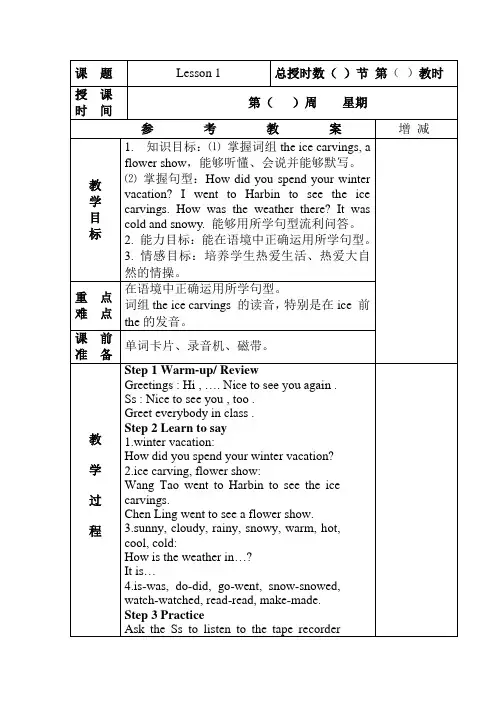
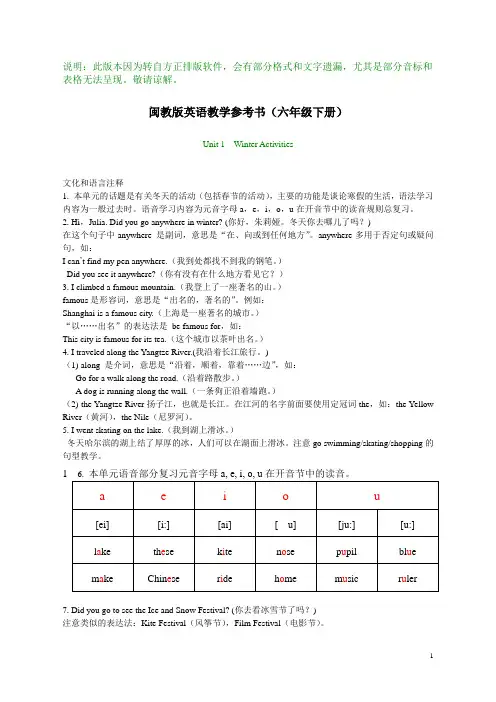
说明:此版本因为转自方正排版软件,会有部分格式和文字遗漏,尤其是部分音标和表格无法呈现。
敬请谅解。
闽教版英语教学参考书(六年级下册)Unit 1 Winter Activities文化和语言注释1. 本单元的话题是有关冬天的活动(包括春节的活动),主要的功能是谈论寒假的生活,语法学习内容为一般过去时。
语音学习内容为元音字母a,e,i,o,u在开音节中的读音规则总复习。
2. Hi,Julia. Did you go anywhere in winter? (你好,朱莉娅。
冬天你去哪儿了吗?)在这个句子中anywhere 是副词,意思是“在、向或到任何地方”。
anywhere多用于否定句或疑问句,如:I can’t find my pen anywhere.(我到处都找不到我的钢笔。
)Did you see it anywhere?(你有没有在什么地方看见它?)3. I climbed a famous mountain.(我登上了一座著名的山。
)famous是形容词,意思是“出名的,著名的”。
例如:Shanghai is a famous city.(上海是一座著名的城市。
)“以……出名”的表达法是be famous for,如:This city is famous for its tea.(这个城市以茶叶出名。
)4. I traveled along the Yangtze River.(我沿着长江旅行。
)(1) along 是介词,意思是“沿着,顺着,靠着……边”,如:Go for a walk along the road.(沿着路散步。
)A dog is running along the wall.(一条狗正沿着墙跑。
)(2) the Yangtze River扬子江,也就是长江。
在江河的名字前面要使用定冠词the,如:the Yellow River(黄河),the Nile(尼罗河)。
闽教版小学六年级下册英语教案全册Unit 1 Taking about the Winter VacationLesson 11.Teaching Aims:1)Vocabulary: ice carving ,flower show2)Patterns:How did you spend your winter vacation?I went to Harbin to see the ice carvings.How was the weather there?It was cold and snowy.2.Teaching difficulties: Consolidate the students to ask and answer3.Teaching Aid: cards and pictures4.Teaching times: 2The First PeriodTeaching stepsStep1:Warming-up Exercise:Read a poem(Summer Vacation)Step 2: Warm1)Review the words about weather:sunny,cloudy,rainy,snowy,warm,hot,cool,cold.2) Show the cards:is,do,go,snow,watch,read,make及其过去式Step 3:Learn to say1)Listen to the tape then let some students explain themeaning.2)Read after the tape ,then ask some don’t know questions.3)Read together.Act the dialogue.4) Major Vocabulary: ice carving ,flower showStep 4: Look and say1)师出示词组卡片,生读并理解意思2)采用不同形式操练3)活动1:耳聪目明4)活动2:限时抢答Step 5: SummaryTell the students notice the different of 动词过去式。
Unit 1 Talking about the Winter VacationLesson 1I.Teaching aims and demands :To demand Ss to hear and speak these words correctly: ice carving,flower show.To demand Ss to hear and speak these sentences correctly: How did you spend your winter vacation?I went to harbin to see the ice carvings.How was the weather there?It was cold and snowy.II.Teaching materials : tape recorder ; some cardsIII.Teaching steps :Step 1 Warm-up/ ReviewGreetings : Hi , …. Nice to see you again .Ss : Nice to see you , too .Greet everybody in class .Step 2 Learn to say1.winter vacation:How did you spend your winter vacation?2.ice carving, flower show:Wang Tao went to Harbin to see the ice carvings.Chen Ling went to see a flower show.3.sunny, cloudy, rainy, snowy, warm, hot, cool, cold:How is the weather in…?It is…4.is-was, do-did, go-went, snow-snowed, watch-watched, read-read, make-made.Step 3 PracticeAsk the Ss to listen to the tape recorder and answer the following questions:How did Wang Tao spend his winter vacation?How did Chen Ling spend her winter vacation?How was the weather in Harbin?How was the weather in Guangzhou?(look and say with the teacher.Divide the Ss into two groups to act out the two dialogs.Ask two Ss to act out the dialogs for some times .)Step 4 Look and sayListen to the tape & look at the English books and point to the pictures. Listen to the tape again & repeat: see the ice carvings, see a flower show, went to the fair, watched New Year programs, read interesting books, made snowmen, at Spring FestivalStep 5 Ask and answerFinish part4: Read. Tick or cross.Step 6 HomeworkListen to the tape & repeat for some times .Finish off the activity book of this Lesson .Lesson 2I.Teaching aims and demands :To demand Ss to hear and speak these words correctly: Seaside, wedding, met.To demand Ss to hear and speak these sentences correctly: Where were you in the winter vacation?I went to Hainan with my family.What did you do there?We played at the seaside.II.Teaching materials : tape recorder ; some cardsIII.Teaching steps :Step 1 Warm-up/ ReviewGreeting each other.Review verbs: is, are, go, do, play, climb, stay, learn,meet及其过去式。
说明:此版本因为转自方正排版软件,会有部分格式和文字遗漏,尤其是部分音标和表格无法呈现。
敬请谅解。
闽教版英语教学参考书(六年级下册)Unit 1 Winter Activities文化和语言注释1. 本单元的话题是有关冬天的活动(包括春节的活动),主要的功能是谈论寒假的生活,语法学习内容为一般过去时。
语音学习内容为元音字母a,e,i,o,u在开音节中的读音规则总复习。
2. Hi,Julia. Did you go anywhere in winter? (你好,朱莉娅。
冬天你去哪儿了吗?)在这个句子中anywhere 是副词,意思是“在、向或到任何地方”。
anywhere多用于否定句或疑问句,如:I can’t find my pen anywhere.(我到处都找不到我的钢笔。
)Did you see it anywhere?(你有没有在什么地方看见它?)3. I climbed a famous mountain.(我登上了一座著名的山。
)famous是形容词,意思是“出名的,著名的”。
例如:Shanghai is a famous city.(上海是一座著名的城市。
)“以……出名”的表达法是be famous for,如:This city is famous for its tea.(这个城市以茶叶出名。
)4. I traveled along the Yangtze River.(我沿着长江旅行。
)(1) along 是介词,意思是“沿着,顺着,靠着……边”,如:Go for a walk along the road.(沿着路散步。
)A dog is running along the wall.(一条狗正沿着墙跑。
)(2) the Yangtze River扬子江,也就是长江。
在江河的名字前面要使用定冠词the,如:the Yellow River(黄河),the Nile(尼罗河)。
5. I went skating on the lake.(我到湖上滑冰。
)冬天哈尔滨的湖上结了厚厚的冰,人们可以在湖面上滑冰。
注意go swimming/skating/shopping的句型教学。
17. Did you go to see the Ice and Snow Festival? (你去看冰雪节了吗?)注意类似的表达法:Kite Festival(风筝节),Film Festival(电影节)。
8.There was a big ice city. There were many people.(有一座很大的冰雕城,那里有很多人。
)注意there be的过去时教学。
如:There was a basketball game between Class One and Class Two yesterday afternoon.(昨天下午一班和二班有一场篮球赛。
)9. Ben and I made a snowman.(我和本堆了个雪人。
)(1)在汉语里,“我和本”要先讲“我”,在英语中“I ”则要放到最后,说成“Ben and I”。
又如:“我和爸爸妈妈”要说成“my father,mother and I”。
(2)snowman(雪人)的复数形式是snowmen,make 的过去式是made。
10. And I took a photo of it on my mobile.(我用手机给雪人拍了张照片。
)此处it指的是“雪人”。
11. Show me the photo,please.(请把照片给我看看。
)这个句子也可以说成Show the photo to me,please.又如:Show me your homework./Show your homework to me.(请把你的作业给我看看。
)12. It’s short and fat.(雪人又矮又胖。
)(1) fat是形容词,意思是“胖的,肥的”。
注意:在英语中说一个人fat会显得很不尊重他人,一般用委婉语stout (壮的)来替代。
(2) short解释为“矮的”时,其反义词是“高的”tall;short 解释为“短的”时,其反义词是“长的”long。
13. Many children go back to their hometown with their parents.(很多儿童和他们的父母一起回到家乡。
)go back to…是“回到某处”的意思,如:Pupils go back to school on September 1st. (九月一日学生们回到了学校。
)14.grandparents是“祖父母,外婆外公”的意思,grandchildren 是“孙子,孙女,外孙,外孙女”的意思。
grandson 是“孙子,外孙”的意思,granddaughter 是“孙女,外孙女”的意思。
15.课本第7页的韵律诗及其译文如下:SightseeingI climbed a mountain,A famous mountain.I traveled along a river,A long, long river.I went skating on a lake,A beautiful lake.观光游览我登上了一座山,一座名山。
我沿着大江旅行,一条长长的江。
我在湖上滑冰,风景秀丽的湖。
Part A教学目标◆语言知识目标1.学习词汇:anywhere,famous,travel,along,the Yangtze River,go back。
2.学习句型:Did you go anywhere in winter?Yes. I went to Shandong.I climbed a famous mountain.3. 复习巩固元音字母a,e,i,o,u在开音节中的发音。
4. 学说韵律诗:Sightseeing。
5. 功能:假日活动。
◆语言技能目标1.能准确使用动词的过去式讲述过去发生的事情。
2.能运用所学语言完成调查任务。
3.能根据调查结果谈一谈一次外出旅游的活动。
◆情感态度合理安排假期,让自己的假期生活愉快而充实。
教具准备1.五个元音字母卡片。
2.有关单词和词组卡片。
3.一张中国地图。
4.录音机或多媒体教学光盘。
教学过程Step 1Warming up1.师生互致问候。
2.教师播放本套教材五年级下册第7页的韵律诗:How Was Your Vacation? 全班学生模仿录音说一说。
Step 2 Review1.根据韵律诗内容,教师说:“Winter vacation was just over. Can you tell me your winter activities?”(板书Winter Activities)2.学生自由说,教师在黑板上板书学生说到的句子中的单词或词组,如:went to…visited…did my homeworkplayed football…3.教师出示学过的动词原形及其过去式,复习它们的音、义、形及变化规律。
4.教师再出示一些动词词组,如:took some photos,went skating,climbed a mountain,listened to music 等,进行复习巩固活动。
5.游戏——限时抢答。
游戏规则:教师随机出示动词过去式的单词卡片,学生按组,一个接一个说出相应的动词词组,看哪一组在限定的时间里说的词组多且不重复。
如:教师出示went第一组学生A:went to Beijing教师出示took第一组学生B:took some photos教师出示played第一组学生C:played football教师出示went第一组学生D:went swimming6.教师揭示课题,并在黑板上写有Winter Activities的地方将课题补充完整:Unit 1 Winter Activities Part A。
Step 3Presentation(一)呈现课文内容并学习新知识1.课文导入。
(1)教师说:“Just now we talked about our winter activities. Look! Wang Tao,Julia and Sally are talking about their winter activities. What did they say?”(2)教师请学生完整地听一遍课文录音或观看多媒体教学光盘,让学生整体感知课文。
并在黑板的左边板书问题:Where did Julia/Wang Tao/Sally go in winter?2.教学句子:I traveled along the Yangtze River.(1)请学生再读课文,然后回答问题。
(2)教师出示一张中国地图,请学生指出the Yangtze River的位置,引导学生说:“It’s the Yangtze River. It’s a very long river.”(3)教学单词travel及其过去式traveled。
(4)教学介词along。
along 的意思是“沿着,顺着,靠着……边”,例如:They are walking along the river.(他们正沿着河散步。
)There are many trees along the street.(沿街有很多树木。
)Walk along this road and you will find the library.(顺着这条路走,你会找到图书馆。
)3.教学单词famous。
(1)教师再提出问题:“What did they do there?”然后分段播放课文录音,请学生认真听并找出问题的答案:Julia climbed a famous mountain in Shandong.Wang Tao took many photos when he traveled along the Yangtze River.Sally went skating on the lake.(2)教学单词famous,并请学生用famous来说一说一些著名的风景名胜,如:—Do you know the Great Wall?—Yes. It’s very famous.I would like to travel along the Yangtze River. It is very famous in the world.Big Ben is a famous clock in the world.4.学习单词anywhere及句型Did you go anywhere in winter?(1)教师在黑板上句子Where did …go in winter?的旁边板书句子:Did you go anywhere in winter?请学生读课文对话,找到该句话,并通过上下文,猜测这个句子的意思。